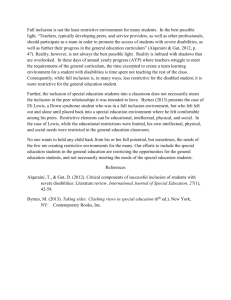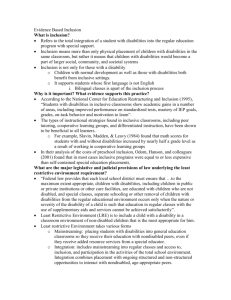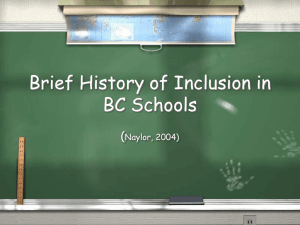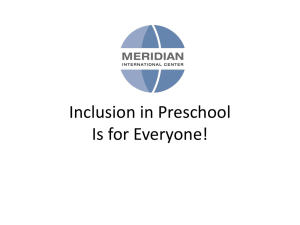Topic 12 - Teaching Inclusion Classes
advertisement
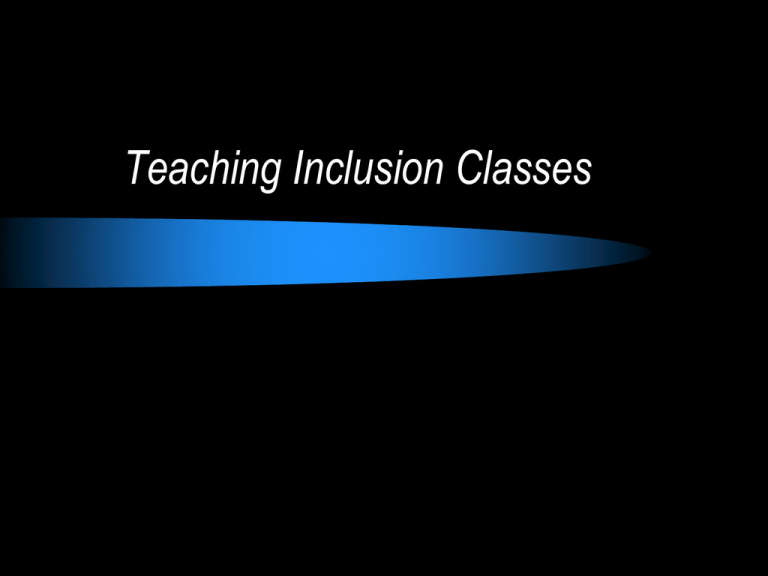
Teaching Inclusion Classes What are some suggestions you can come up with for how to make inclusion work in the classroom. Write down 5 in your notebook. 1. 2. 3. 4. 5. 6. 7. 8. 9. 10. 11. 12. 13. Feedback skills with one another Variety of equipment with choice Learn about the disabilities Partner (disabled with non, higher skill with lower skilled) Group responsibility for student with disability Rule modifications for games Teaching styles with some that allow for more individual attention (peer and station work) Multiple solutions to question posed by teacher, can answer at one’s own ability level Balance cooperative vs competitive activities Effectively utilize aides to facilitate inclusion Positive affective environment (Discuss the student/disability with the remainder of the class) Clear expectations and instructions Activity matrix (task analysis) – can modify any portion of the task analysis. Remember, inclusion is designing a regular PE lesson but making adaptations for special needs students. These modifications will be listed under the “differentiated instruction” portion of the lesson plan. CT Legislation According to the “PJ Law,” 80% of special needs students must be educated in an inclusion environment. 1. Modifications Remember to modify the rules and the equipment. Some students may be sensitive to modifications in front of their peers, this should be done on a case by case basis. How can you overcome this? Intra-task variation • Remember, we talked about modifying any part of a task analysis to promote success. 2. Involve the class/student Ask students without disabilities how best to incorporate a special needs student into class, typically when the special needs is not present. The students will often come up with solutions you already know but this helps involve everyone and increase ownership. If a special needs student is unable to contribute to the group work, take the student aside and ask about the situation to determine his or her perception. Find solutions that address the student's answer and use alternative ways to address his or her involvement. 3. Contact Theory Contact theory suggests that frequent, meaningful, and pleasant interactions between individuals with differences tend to produce changes in attitude (Sherrill, 2003). To be successful, interactions between students must be planned and implemented carefully such as picking teams in a discreet and equitable manner, often before class begins. The atmosphere should be cooperative rather than competitive, and the teacher must model positive behavior. Aka – don’t hide away your adapted students, plan & follow through. (Block, 1999) - Students without disabilities reported increases in their self-concept, tolerance, self-worth, and understanding of other people. 3. Contact Theory The flip side - Be vigilant for opposition or hostility towards students with disabilities from non-disabled students. Example: Students may verbally oppose students with disabilities being on their team. How might you handle this: • Use more non-competitive activities • Include an affective/participation rubric • Assign that student as a peer helper 4. Behavior Management Transitional episodes – plan and forewarn of changes within the class (e.g., team selection, lining up, moving squads, etc.) Results showed there was less student learning and more off-task behavior for students with disabilities in inclusion settings (Palaestra, 1999) First year teachers should avoid extensively included classes if possible Higher rates of burnout (Fejgin, 2005) 5. Prior Notification Prior to the first day of classes, inquire about special needs students you may have in class. Best place to start is the special education office Must wait until you have your roster. 6. Other ideas to improve inclusion? Any ideas we’ve missed? Peer tutoring – set up a program at the start of the year Disability awareness – great time is at the start of the school year In-services – get better by requesting leave for other schools or workshops. Obstacles to Inclusion Number of students in your classroom PE classes are often capped at 30 students per class. If possible, lobby for counting each IEP student as 2 or 3 towards that cap. (Brown et al., 1989) – Principle of "natural proportions,” no more than 1-2 students with disabilities in any one PE class. Time Conducting specialized assessments and lesson planning takes just that – time. Obstacles to Inclusion Functional exclusion Occurs when physical educators include a student with a disability in class, but the student does not meaningfully participate with his or her peers. What are some examples: • A student may be "allowed" to watch others, keep score, clean the equipment room, inventory equipment, play "catch" with a paraeducator, or even help the teacher with a task. Obstacles to Inclusion Changing the Culture of Inclusion • Inclusion cannot be accomplished solely through the addition of a paraeducator, or the adaptation of games, equipment, time, and/or organization (Rizzo & Lavay, 2000). Video Watch the following video and create an inclusion movement education lesson on pathways (3rd grade). If you are unsure what a movement education lesson is, go to my website and click the link for “K-12 teaching materials.” autism news segment_0002.wmv Possible Answers Intro: Walk along the lines (vary LM movement) Routine (warm-up stations, choice at each station) Focus Partners, noodle to bind them (written pathway, draw in advance) – Q Ss Pac Man Tag Culminating Walk along the lines Follow the leader Pathways assessment
